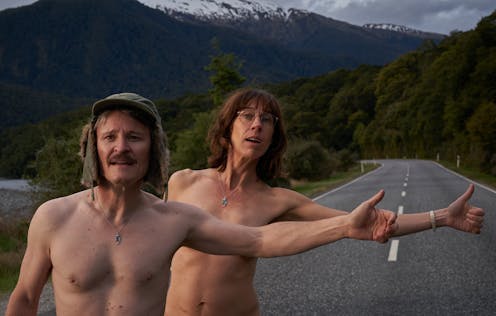Nude Tuesday has a sex therapy retreat, an egotistical guru, a script in gibberish – and two very different translations
- Written by Ari Mattes, Lecturer in Communications and Media, University of Notre Dame Australia

Review: Nude Tuesday, directed by Armağan Ballantyne
Nude Tuesday is a tale of two films – two subtitle tracks, anyway.
Directed by Armağan Ballantyne and written by Jackie van Beek, who also stars, the whole thing is spoken in a Scandinavian-inspired gibberish.
Comedian Julia Davis subtitled the first version of the film, a recent crowd-pleaser at the Sydney Film Festival and now playing in select cinemas, and comedians Celia Pacquola and Ronny Chieng subtitled the second version for Stan, where it joins the Davis version.
Both follow the same narrative structure. Bored middle-class couple Laura (van Beek) and Bruno (Damon Herriman) lead a banal existence, sharing a mildly dysfunctional relationship while living and working on fictional Pacific island Zǿbftąņ.
They have two daughters, no longer have sex, and are fairly unimpressive in their uninteresting jobs.
For their anniversary, Bruno’s mum gives them a voucher to a sex therapy retreat in the mountains. When they reluctantly arrive at the retreat, presided over by egotistical guru Bjorg Rasmussen (a likeable but caricaturish Jemaine Clement), the pre-existing fissures in their relationship break wide open.
Laura embraces the “treatment” straight away, whereas Bruno remains resistant to it. When Laura has an erotic encounter with Bjorg, the couple split up, before coming together again at the end.
Read more: The 5 best films from the 2022 Sydney Film Festival
A cinematic experiment
Despite the fact the film’s vision and sound are identical in both versions, the affect of each is significantly different – to the extent, I would suggest, that a fan of the Davis version would not necessarily enjoy the Chieng/Pacquola version, and vice versa.
The significance of the actual words of a film (versus merely dramatic arcs and scenarios) comes into stark relief in this experiment. This is where Nude Tuesday is most interesting: as a cinematic experiment demonstrating the power of the spoken word to move viewers in different directions.
Davis’ version relies on daggy and only sometimes funny toilet humour and infantile sex gags. It’s the kind of film that would appeal to people like the main characters: repressed types who think nudity, sex, euphemisms for genitalia and anodyne tripping experiences are inherently funny.
There are menstruation jokes, gags about volume of ejaculation, and plenty of scatalogical humour (“Let’s birth our brown bottom babies,” Rasmussen declares, straight-faced, in a therapy session).
The problem is, the whole thing is already sufficiently silly that the additional jokes in the dialogue come off as forced as often as not, and Nude Tuesday quickly wears thin.
The Chieng/Pacquola version features more carefully crafted dialogue, relying on verisimilitude in relation to the absurdity of the premise rather than broad toilet humour.
It is, as a result, more watchable – even if it features fewer laugh out loud moments. The dialogue is more deadpan and less deliberately bawdy, and, given the scenario is silly enough as it is, this makes its padded out 100 minutes more bearable.
Read more: What We Do in the Shadows – the NZ gothic with sharp comic chops
Funny, but not that funny
The films are, of course, technically identical, and there are consistencies between them.
Herriman is an excellent actor, and he adds a touch of pathos to his (predominantly comedic) role as a bitter and hopeless man, which anchors both versions.
“Nobody needs me. I’m just a broken little man,” Bruno cries in the Davis version, holding a shotgun to his chin.
Clement’s performance is similarly effective in lampooning New Age culture, and he plays the part of guru-charlatan with a subtly menacing quality that makes it more believable.
The whole cast, in fact, demonstrate exceptional chops in speaking authentic gibberish, with believable modulation and intonation – far more difficult to do than people might think, given the direction words pull performances.
The film is effectively shot on New Zealand locations, with the contrast between the warmly lit interiors and the cold exteriors successfully mapping the tensions between the characters.
Though enjoyable, Nude Tuesday is far from a masterpiece. It’s funny but not that funny, and labours too hard at its conceit.
It is also far too long. It begins to wear thin after an hour, and both versions would work better at a more economical 80 minutes. To hold it up as a splendid example of absurdism – as have some reviews – is a huge overreach, and a description more applicable to far sharper, more misanthropic comedies like Yorgos Lanthimos’ brilliant The Lobster (which surely must have been an influence on this?).
Both versions of Ballantyne’s film are pretty tame by any standards, but while the Davis version feels affected in its attempts at gross-out humour, the Chieng/Pacquola version comes off as sweet-natured (if a little dull) in its more restrained tone.
I can understand the pleasure of seeing the Davis version in a cinema with an audience, but I suspect the Chieng/Pacquola version will play better on the small screen.
In any case, both versions will be available on Stan. If neither appeals to you, try the third version which features no subtitles. The gibberish versions of pop songs, including Kenny Rogers’ and Dolly Parton’s Islands in the Stream, are probably the best thing about the film. And who needs subtitles for these?
Nude Tuesday is out now on Stan and in select cinemas.
Authors: Ari Mattes, Lecturer in Communications and Media, University of Notre Dame Australia





